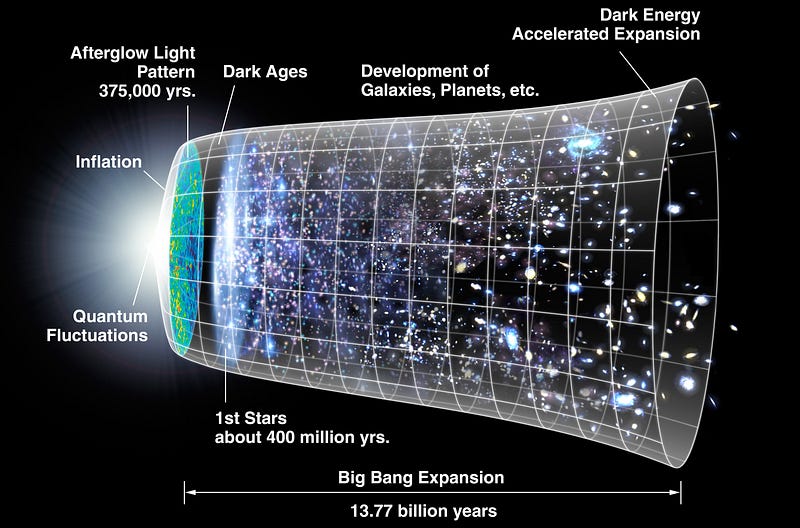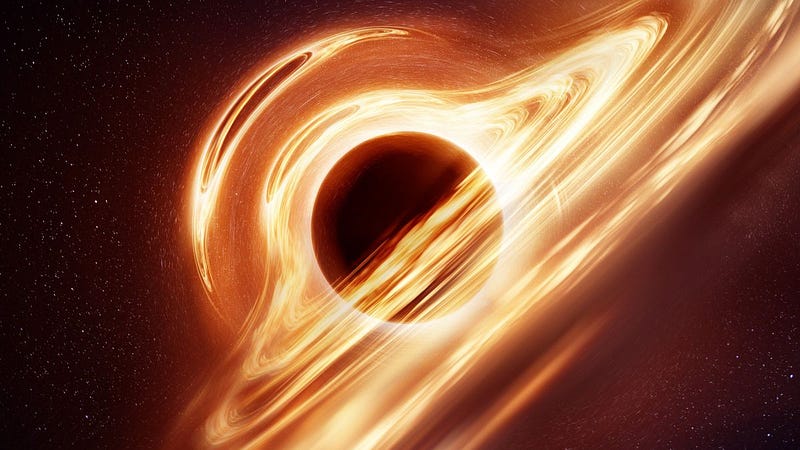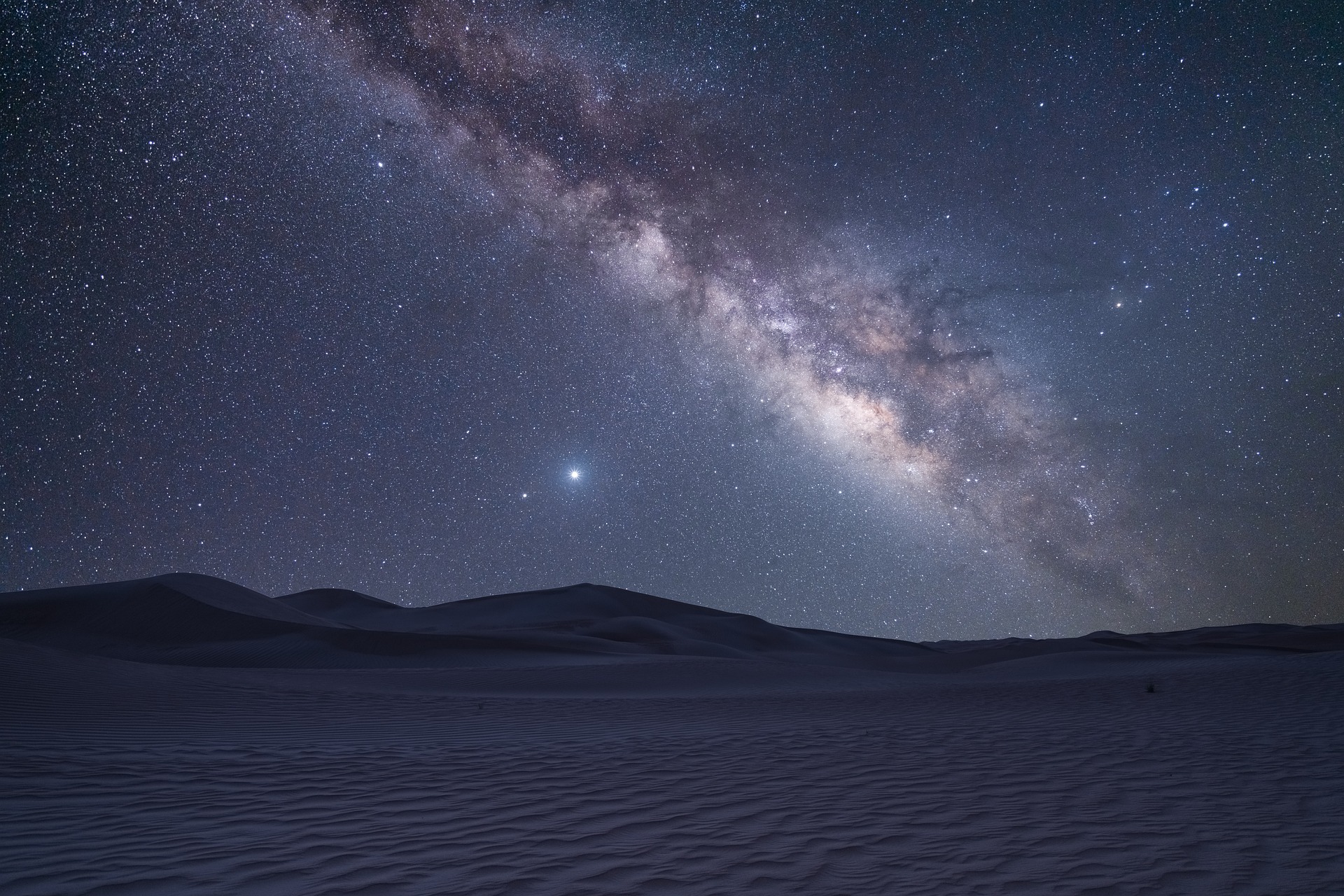We humans are curious creatures. From our earliest days, we’ve asked questions about everything. While with the advent of science and technology, we’ve been able to answer most of those questions, there are still a few that continue to elude us — a few that remain unsolved. And one such question is — “Is the Universe infinite?”
The universe is mind-bogglingly large. But is it infinitely large? Or is there a limit? If that is so, what lies outside that limit? Are we a part of the multiverse? Why is science unable to provide definite answers? Will we ever find any answers? Let’s dive right in.

Where it all began:
According to the big bang theory, the universe as we know it today began as an infinitely dense and hot point called the singularity, which inflated at an inconceivable speed 13.8 billion years ago filling itself with matter, antimatter, and radiation, thus creating our ever-expanding cosmos.
We know this because of the Cosmic Microwave Background radiation, which is the leftover radiation from the Big Bang, an echo of the early universe. Scientists have accurately measured this radiation and it provides good enough evidence to support the Big Bang Theory.
While it is not the only theory about the universe’s origin, it is certainly the most well-supported, accepted, and popular one.
The Expansion:
Whatever might have been the reality of our origin, we know one thing for sure, the universe is expanding.
How can we be so sure?
Well, in 1924, astronomer Edwin Hubble used a technique to measure distances to remote objects in the sky. He discovered that the speed at which astronomical objects move apart is proportional to their distance from each other. In other words, the farther away objects are from Earth, the faster they are moving away from us. This became known as Hubble’s law and was later used as evidence for our expansion.
Later, astronomers observed that light from distant objects in the universe is redshifted. This redshift is the result of galaxies moving away from us. And this observation is true no matter what direction we look at. This means that whatever place you happen to be in this universe, all the other galaxies will be moving away from you. This is because the universe has no center, and everything is moving away from everything else.
So, what does the expansion of our universe mean?
Well, it means that it has been growing ever since it began with the Big Bang.
But wait, if the universe is infinite, how can it expand? Or if it is not infinite… then what is it expanding into?
Let’s find out.
The observable part:
Much of what we know about our universe comprises the “Observable universe”, which is a region of space of diameter 93 billion light-years, which humans can in theory observe from the earth using technology. It contains an estimated two trillion galaxies and every other celestial thing that we know of. What lies beyond that, we don’t know as light from that region is yet to reach us. We speculate that it is the same as the observable universe — More galaxies, stars, black holes, and other celestial bodies.
Another theory talks about something called the “Darkflow”. In 2008, astronomers observed that instead of expanding uniformly outwards, many galaxies are moving in a preferred direction. This unexplained motion is termed the Darkflow. Could there be some monstrous unimaginable force that lies beyond that we are unaware of? Or could it be another universe?
The limits of our universe simply boil down to two simple possibilities. The universe is finite, and the universe is infinite. Let’s try to explore each of these possibilities individually.
What If The Universe Is Infinite:
As we look to greater distances, the light we see from the Universe comes from its progressively younger days. In doing so we found that, in its earlier days, Universe was almost perfectly uniform, with a few irregularities. These imperfections were enough to grow into the stars, galaxies, and galaxy clusters we see today. These measurements of our early universe also indicate that the Universe is spatially flat. Therefore, if the universe is infinite, its shape would be like an infinite sheet of paper.
It also indicates that the universe has always been infinite. At the Big Bang, it was infinitely dense. Since then, it has just been getting less dense as space has expanded.
An infinite universe also means that it is not expanding into anything. Because the universe’s size is already infinite, its size can’t increase. Rather, it’s stretching — like a sheet of rubber.
If the universe is infinite, then there are almost certainly other life forms out there.
But there’s one problem. Infinity doesn’t obey the normal laws of arithmetic. Half it or double it, we still get infinity. So, there’s the issue with probability. And if the entire universe is like that of the observable universe, that means there will also be limitless planets and galaxies. Such a universe would go on forever and ever and ever in all directions, and include every possibility, including an endless version of “Us”! Everything that can happen will happen. And therefore, you can be certain that there is another “you” at some other part of this universe doing the same thing as you are!
California Institute of Technology theoretical physicist Sean Carroll stated that he feels the universe “probably is infinite.” And if so, “then either an infinite number of different things happen or a finite number of things happen an infinite number of times. Either possibility is pretty mind-boggling.”
What If The Universe Is Finite:
Things get interesting if you consider our universe to be finite. It means that you can theoretically measure the size of our entire universe. It also opens the possibility that our universe might not be “Everything”. But a finite universe also means that there is an edge to it right? Well, that entirely depends on its shape. So, let’s start with what might be the shape of a finite universe.
Some scientists think it’s possible the universe is curved or loops back on itself. If that’s true, it would mean it is not infinitely big — although it would still be bigger than our imagination. A closed universe would be like the surface of a sphere, that is, a straight line will eventually return to its starting point. But Current observations and measurements of the curvature of the universe indicate that it is almost perfectly flat. So, for a flat, finite universe, the best possible shape would be that of a two-dimensional torus or a donut. Other possible shapes could be like a mobius strip, a “three-torus” or maybe a Klein bottle.
Estimations also suggest that if the universe is finite, it must be more than 250 times larger than the observable universe, which is stupendously large and beyond our grasp and comprehension.

Now let’s look at the various theories for a finite universe.
Theory #1: Although the universe is finite, there is nothing outside of it, that is, it is Everything
This might be a little hard to picture. When we imagine the universe, we see it as a giant ball that’s filled with stars, galaxies, and other celestial bodies. And we imagine it from the point of view of someone floating outside of this giant ball, like how an astronaut views earth from orbit.
But the universe doesn’t need any outside perspective to exist. It is entirely mathematically self-consistent to define a three-dimensional universe without requiring any “outside” of that universe.
Theory #2: Our universe is part of a “Super” universe
Some think that our universe may lie inside some “Super” universe that we are expanding into. There might be a series of other universes lying inside this infinity of space, time, and matter.
Theory #3: Multiverse theory
The multiverse theory is one of the most popular theories about what lies beyond our universe. In simple words, the multiverse theory states that the whole of our universe could exist in a small “bubble” amid a vast array of other bubbles called the “multiverse”, with each of these universes containing a different reality. This gives rise to the idea of parallel universes. If the multiverse theory is correct, then there’s a universe out there where everything is exactly like this universe.
Columbia University physicist Brian Greene stated that “our universe is one of potentially numerous ‘slabs’ floating in a higher-dimensional space, much like a slice of bread within a grander cosmic loaf,” in his book “The Hidden Reality”.
Quantum mechanics describes our world in terms of probabilities. The mathematics of the multiverse theory suggests that all possible outcomes of a situation do occur, in their separate universes.
“And in each universe, there’s a copy of you witnessing one or the other outcome, thinking — incorrectly — that your reality is the only reality,” Greene wrote in “The Hidden Reality.”
The multiverse theory is also supported by the theory of Eternal Inflation that we’ll discuss later.
Theory #4: We live inside a black hole

Black holes are stellar objects with a gravitational force so strong that not even light can escape them. It is formed when a star at the end of its life collapses under its gravity into a tiny region of infinite density — the Singularity. And most scientists agree that our universe too started as a singularity, is that a coincidence? The singularity itself is a mystery as we are yet to find out what lies in it. Some claim that our universe lies inside one such black hole. The gravitational pull that we observe from outside a black hole is on the inside an ever-expanding spacetime, pushing the border further away from everything. In the same way, our universe expands.
The event horizon, the region surrounding the center of the black hole, grows as matter falls into a black hole — rapidly in the beginning as the black hole starts to form, then more slowly as matter falls in at a lower rate. During the first trillionth of a second after the Big Bang, the universe expanded incredibly fast, even faster than the speed of light. The expansion slowed over time, much like the event horizon.
Theoretical physicist Nikodem Popławski stated that our universe might have come from a fraction of a much bigger universe, which got sucked into a black hole and compressed until it reached an infinitely dense state. This core fragment, affected by gravitational spin, then exploded violently, forming our current universe as we know it. This core might be the source of our big bang.
This also opens the possibility that the black holes in our universe may be home to other universes!
There are many other theories and possibilities about what lies beyond. Like the one that claims that the universe is expanding into a higher dimensional space-time, we might be living in a ‘bubble’ between other five-dimensional spaces. Yet another theory claims that we might all be living inside a hologram — which means everything we see, and experience is nothing but an illusion.
That said, if the universe is finite, it means there is a very high possibility it will come to an end someday in some way, whether it’s via the big crunch or the big rip.
Theory Of Eternal Inflation:
Now let’s look at a very interesting theory that is an extension of the Big Bang theory and if true, might prove the existence of the multiverse! I’m talking about the theory of eternal inflation.
According to the eternal inflation theory, once inflation starts, due to quantum effects, it never completely stops. Rather, it ends in places, and universes form there. Therefore, once inflation happens, it produces not just one universe, but an infinite number of pocket universes or “bubbles”.
Theoretical physicists Alan Guth and Stephen Hawking envision our universe as one of these countless bubbles.
Everything we see in our Universe, is, therefore, contained in just one of these bubbles — in which inflation has stopped, allowing for the formation of galaxies.
“The usual theory of eternal inflation predicts that globally our universe is like an infinite fractal, with a mosaic of different pocket universes, separated by an inflating ocean,” Hawking explained.
Although this looks like an interesting theory, scientists are yet to confirm its viability. Cosmologist Thomas Hertog thinks that the eternal inflation model is wrong. “The problem with the usual account of eternal inflation is that it assumes an existing background universe that evolves according to Einstein’s theory of general relativity and treats the quantum effects as small fluctuations around this,” Hertog explained.
A 2014 paper by Kohli and Haslam concluded that the theory of eternal inflation based on random quantum fluctuations would not be viable, and the resulting existence of a multiverse is “still very much an open question that will require much deeper investigation”.
What does religion have to say about all this?
So, if science is unable to provide any definite answer about the limits of our universe, I was curious to see if religion can. After all, throughout human history, science, and religion have been closely intertwined with each other and had a very dynamic relationship. They provide two different windows for looking at the same world.
Let’s see what different religions have to say about the universe.
The Hindu cosmology considers all existence as cyclic, that is, our universe is preceded by an infinite number of universes and to be followed by another infinite number of universes. This to some extent aligns with the Big Bounce theory. The Hindu texts describe innumerable universes existing all at the same time moving around like atoms. The concept of the multiverse is mentioned several times in the Bhagavata Purana, Brahma Vaivarta Purana, and Yoga vasistha.
According to Buddhism, there is no beginning nor end to the universe. It considers all existence as eternal, and views the universe as something in constant flux, passing in and out of existence, parallel to an infinite number of other universes doing the same thing. The concept of infinite worlds is mentioned in the Apannaka Jataka.
The idea of a multiverse is also compatible with an Islamic worldview. There are seven verses in the Quran describing the seven heavens. Fakhr al-Din al-Razi, an influential Muslim polymath, argued that there exists an infinite outer space beyond the known world and that God has the power to fill the vacuum with an infinite number of universes. Ibn Arabi, a Muslim scholar, held that, since God is endless, consequently there can be no end of created universes.
Conclusion:
So, what is the answer then? Is the universe truly limitless? Or are we living in a multiverse of many bubble universes? The bitter truth is that despite all the recent technological developments, we simply don’t have enough information to definitively answer this question. All we can do is speculate. If the universe is infinite, it will always get bigger, and we will never be able to measure it. If it is finite, it is still mind-numbingly larger than the observable part due to expansion. Either way, the “edge” of the universe might always stay out of our reach. So far, there is more evidence pointing towards an infinite universe than to a finite one. But as of now, this age-old question remains unanswered.



